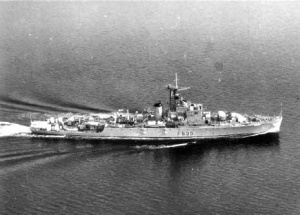HMAS Shoalhaven was ordered as part of Australia’s shipbuilding program during the Second World War. Twelve of these Australian built frigates were to enter service with the Royal Australian Navy. A further 10 were ordered but cancelled as the war drew to a close.
Eight HMA Ships Barcoo, Barwon, Burdekin, Diamantina (I), Gascoyne (I), Hawkesbury (I), Lachlan and Macquarie, were built to the British River Class design and Australia likewise named its frigates after Australian rivers. A further 4, HMA Ships Condamine, Culgoa, Murchison and Shoalhaven, were also named after Australian rivers but were built to the design of the Royal Navy’s Bay Class Frigates. These latter ships were generally known as Modified River Class Frigates although they are sometimes referred to as Bay Class.
Shoalhaven commissioned at Urangan Jetty, Hervey Bay, Queensland, on 2 May 1946 under the command of Commander Rodney Rhoades DSC RAN.
It was attached to the First Frigate Flotilla and after a short shakedown cruise, proceeded to New Guinea waters in June 1946, subsequently visiting the New Hebrides where it was host to the British Resident Commissioner for a short period. Shoalhaven returned to Australian waters in September 1946.
During 1947 and 1948, Shoalhaven deployed to New Guinea on a further 3 occasions: January to May 1947, September to November 1947 and July to September 1948. During these periods Shoalhaven conducted operations with a Rendering Mines Safe Unit. During the remainder of the 2 year period, it exercised with other units of the Royal Australian Navy in home waters.
On 21 January 1949 Shoalhaven sailed for the Far East where it joined units of the Royal Navy and the United States Navy for combined exercises. After a visit to Hong Kong it proceeded to Shanghai, where it was from 17 to 28 February 1949 and again from 24 March 1949 to 25 April 1949, and where it was associated in a minor way with HMS Amethyst of the Yangtse River Incident fame.
It returned to Australian waters in June 1949, where it remained until its return to the Far East in January 1950 as a unit of the British Commonwealth naval force, operating in Japanese waters.
With the outbreak of the Korean War on 25 June 1950, Shoalhaven began war operations as an escort for American transports running between Sasebo in Japan and Pusan in South Korea. On 7 July it relieved USS De Haven on the west coast blockade patrol, working with USS Collett for 3 days before returning to Sasebo. This was its only patrol of the Korean War. It then reverted to its former role of escorting convoys between Sasebo and Pusan. This duty occupied the remainder of Shoalhaven’s service in the operational area. The fourteenth and last convoy escorted by Shoalhaven reached Pusan on 31 August. On 6 September 1950 Shoalhaven departed Kure to return to Australia.
During 1951 and 1952 Shoalhaven operated in Australian waters, although it visited the New Guinea area in May 1951 and again in September/October 1951. In October 1952 Shoalhaven supported the first British atomic test at the Monte Bello Islands.
Shoalhaven remained in home waters in 1953 and for the period of September to November 1953 accompanied the Japanese Pearling Fleet off Darwin.
It again proceeded to the Far East in July 1954, visiting Hong Kong, Japan and Korea for post Armistice patrols, before returning to Sydney for refit in March 1955. It subsequently operated in home waters. Following another period in the Darwin area with the Japanese Pearling Fleet, Shoalhaven returned to Sydney in November 1955.
Shoalhaven paid off into Reserve at Sydney on 19 December 1955. It had steamed over 226 000 miles since commissioning. A year later, on 20 December 1956, the ship was accepted into extended Reserve.
Without being brought forward for further service, Shoalhaven was sold in January 1962 to H C Sleigh & Company, acting on behalf of Mitsubishi (Australia) Pty Ltd.
Specifications
 |
| Class |
Modified River (Bay) Class |
|---|---|
| Type |
Frigate |
| Pennant |
K535 |
| Builder |
Walkers Ltd, Maryborough |
| Laid Down |
1 December 1943 |
| Launched |
14 December 1944 |
| Launched by |
Senator Dorothy Tangney |
| Commissioned |
2 May 1946 |
| Decommissioned |
19 December 1955 |
| Dimensions & Displacement | |
| Displacement |
|
| Length | 301 feet |
| Beam | 36 feet 6 inches |
| Draught | 12 feet |
| Performance | |
| Speed | 19.5 knots |
| Complement | |
| Crew | 175 |
| Propulsion | |
| Machinery | Triple expansion, 2 shafts |
| Horsepower | 5500 |
| Armament | |
| Guns |
|
| Other Armament |
|
| Awards | |
| Battle Honours | KOREA 1950-53 |